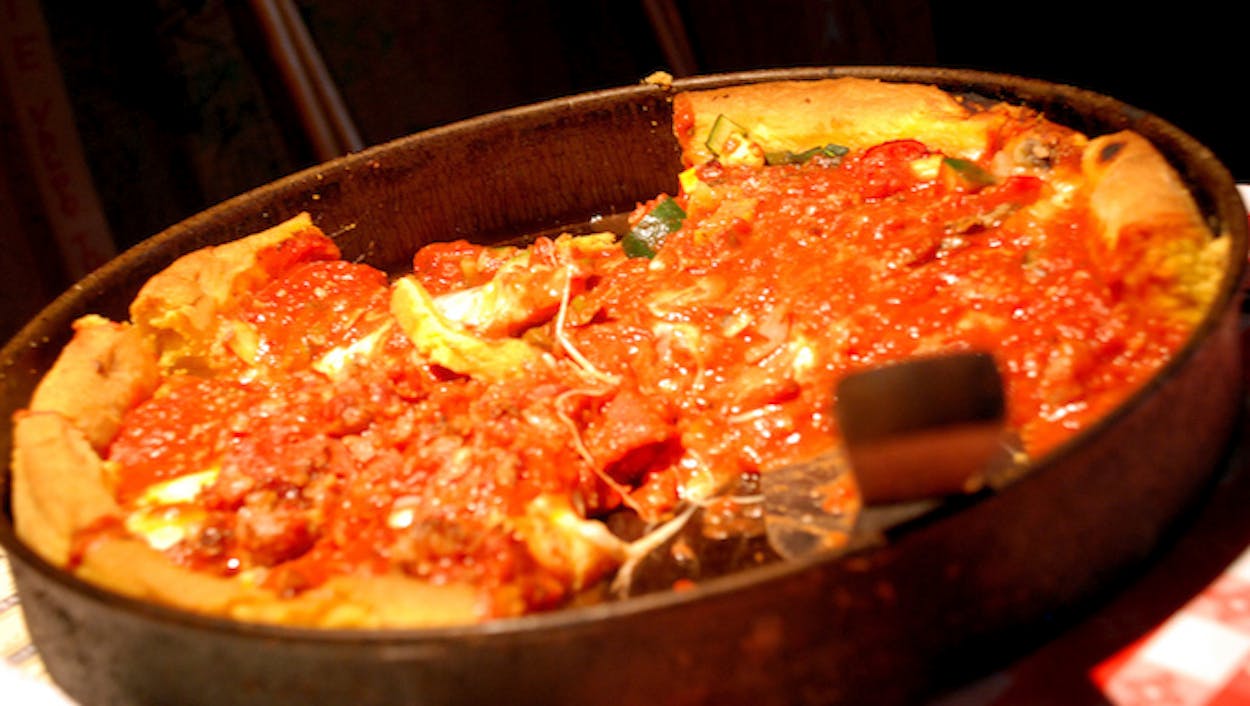As the saying goes: I wasn’t born in Texas, but I got here as fast as I could. I shivered through my early winters in the suburbs of Chicago, moved around a lot as a kid, and finally experienced some sense of home when my family landed in McAllen. And while I’ve taken to Texas as my home in the years since—I have a tattoo of the Alamo on my arm—part of doing your growing up in more than one place is that you take pieces of all of them with you. For me, it’s a deep, abiding affection for Chicago pizza. Specifically, the pizza that comes from Gino’s East, a small chain with four locations in the city of Chicago proper, another half-dozen in the suburbs, and—as of this year—five restaurants in Texas.
The fact that Gino’s East pizza—which isn’t the most famous Chicago pizza chain (that’d be Giordano’s or Uno’s) or the most critically adored (that’d be Lou Malnatti’s)—is the one that exists in my adopted home is a stroke of fortune that it’s still hard to fathom. Like a lot of families that do a lot of moving around, mine sought a way to connect with where we came from through food. For some, that means making tamales at Christmas in Canada. For mine, it was a nigh-religious belief that Gino’s East makes the best pizza in the entire world.
My parents have never been people prone to indulgences more extravagant than basic cable. We weren’t abjectly poor, but during my childhood, my shoes came from Payless. The primary luxury product of my childhood as we moved is that we would occasionally have Gino’s East pizzas shipped to Florida, Nebraska, and finally Texas, and keep them in the freezer. On special occasions, the deep pan my parents bought specifically to properly cook a frozen Gino’s East pizza would emerge from the cabinet, and we would celebrate whatever there was to celebrate (a new job, a Bears win, a high school graduation, etc) a with a gooey pile of cheese, packed atop a deep cornmeal crust and topped with thick, chunky red sauce.
As an adult, every trip I’ve taken to Chicago has begun with a visit to Gino’s East. So when, late last year, Gino’s East announced that they would be expanding to Texas, with five locations—two in the Houston area, one in San Antonio, one in Arlington, and one a few miles from my house in Austin (which opened this week)—it seemed like somebody had been eavesdropping on my family.
That “somebody” is Doug Guller. Guller’s a Chicago guy, but he built his empire in Texas, first with the Bikini’s breastaurant chain, and later with the expanded ATX Brands, which operates a dozen bars/restaurants/businesses where the employees are less, er, exposed.
The breastaurant business is tacky, but Gino’s East is perfection on a plate. There are traditionalists who insist that Chicago pizza isn’t pizza at all—Jon Stewart rallied them to the cause a couple of years ago—but that’s nonsense. As humans, we should be proud that we are members of a species that realized that something as good as thin, flat, cheesy/tomato-y pizza could actually be improved upon if you prepared it on a thick, cornmeal-based crust, and inverted the placement of the cheese and tomato sauce, which preserves the flavor but keeps the cheese deliciously gooey. That we are capable of taking something that requires no improvement, and made it better, gives me faith in humanity.
To that end, I’m fascinated—if skeptical—about the Texas-specific version of the menu that Guller and ATX Brands offer to Gino’s East customers at the new locations. On Superior Street in Chicago, Gino’s East pizzas are all made with red sauce and mozzarella cheese—in Texas, you can get one with BBQ sauce and cheddar, topped with brisket. Guller’s restaurants offer an appetizer called “Deep Dish Nachos,” and if you like pesto or alfredo sauce as your pizza base, just say the word and the Chicago recipe will be adjusted to your taste. (The Chicago locations of Gino’s East do offer BBQ Brisket Sliders now on the appetizer menu, so it seems some cross-pollenization can be good for the Windy City, too.) It’ll probably take more than a few visits to Gino’s East before I’m looking to take a break from my usual (red sauce, cheese, pepperoni—with deep dish pizza, less is definitely more), but it’d be hypocritical for a Chicago pizza enthusiast to insist on the sanctity of tradition.
And the idea that there can be “more than a few visits to Gino’s East” without having to get on an airplane is bonkers. I could get bored with it and decide to experiment with chicken, blue cheese, and buffalo sauce. (Though, at nearly an hour cooking time for a deep dish pizza, I’d have to be very committed to the idea of experimentation.)
This is how the franchising of culture works, and while we lament it when it gets too overwhelming—I’ve shook my head over the Starbucksization of the World—these touchstones of home are really important. Even Texas expats who’ve embraced Chicago as home are grateful for the Uncle Julio’s on North Ave. when they’re craving breakfast tacos, and I know more than a few Texans in New York who cried tears of joy when the Alamo Drafthouse announced its expansion plans. The word “home” carries a lot of connotations. For me, it’s been Texas, with sweltering summers and really good brisket and the Alamo, for most of my life—but now that I can experience the family tradition of a Gino’s East pizza anytime I go downtown, “home” feels even more complete.








